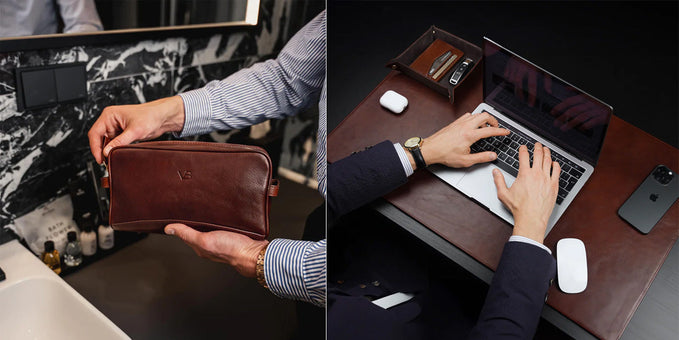Leather

Leather is a tough, flexible, and durable material which is obtained from tanning or chemically treating animal skins and hides to stop it from decaying. Leathers are commonly sourced from species like sheep, cattle, goats, buffalo, hogs, pigs, and water-based animals including alligators and seals.
What is leather used for?
Leather is used to manufacture a wide range of goods. These include clothes, shoes, furniture, handbags, tools, and sports equipment. One of the reasons why leather is used to make these goods is that it can help them last for decades. Leather has been made for over 7,000 years. Some of the leading manufacturers of leather are India and China.
Critics of leather say that manufacturers partake in practices which are hazardous to the environment as well as people.
How is leather produced?
The leather manufacturing process is divided into three sub-processes, which are the preparatory stages, tanning and crusting. A fourth process, finishing, sometimes occurs. However, not all leathers are finished.
The preparatory stages occur when the hide is prepared for the tanning process. These stages can include soaking, hair removal, liming and deliming, bating, pickling and bleaching.
More about tanning
The tanning process stabilizes the proteins – especially collagen – of the rawhide. This makes the hides and skins more thermally, chemically and microbiologically stable so the product is suitable for a wider range of end applications. The main difference between raw and tanned hides is that the raw hides dry out to create a hard and inflexible material. When this material is rewetted, it will putrefy. Tanned material will dry out to a flexible form that won’t become putrid when it’s rewetted.
Manufacturers can opt for various tanning methods and materials. During the most common process, tanners load hides into drums and immerse them in a tank that has the tanning liquor inside it. The hides will soak whilst the drum rotates, with the liquor slowly penetrating through the hide. Once the penetration process is achieved, a process known as basification is used to raise the pH of the liquor slowly. This is used to fix the tanning material to the leather. The more tanning material is fixed to the leather, the more hydrothermally stable and resistant to shrinking the product will become.
Crusting
This process is designed to thin and lubricate the leather. It commonly includes a coloring process. If chemicals are added during the crusting process, they must be fixed in place. Crusting ends with a drying and softening process. It can include methods like shaving, dyeing, whitening, and splitting.
Some leathers receive “finishing”. This is where a surface coating is applied. Finishing can come in the form of brushing, oiling, coating, polishing, glazing, embossing, or tumbling.
It’s possible to oil leather to boost its resistance to water. This process supplements the natural oils in the leather, which can be washed out if the material is repeatedly exposed to water. By oiling leather with mink oil, neat’s-foot oil or a similar product, you can keep leather supple whilst increasing its lifespan.
Which tanning methods are available?
Numerous tanning methods are used by manufacturers of leather. Let’s take a look at some of the most popular options right now.
Vegetable-tanned leather
Vegetable-tanned leather can be tanned with tannins that are extracted from vegetable matter. These can include tree bark which is prepared in bark mills. This method is the oldest known. Vegetable-tanned leather is supple and light brown. The exact shade will depend on the mix of materials used as well as the color of the skin. The color tan takes its name from the appearance of undyed vegetable-tanned leather.
This kind of leather isn’t stable in water. It does tend to discolor and can shrink and become harder if it is left to soak and dry. Vegetable-tanned leather can shrink substantially and start to congeal in hot water. It can also become rigid and brittle when placed in hot water. Vegetable-tanned leather has been used for bookbinding and was sometimes used for armor after hardening in the past.
Chrome-tanned leather
Chrome-tanned leather is tanned via the use of chromium sulfate and other kinds of chromium salts. It is sometimes called “wet blue” leather due to its pale blue color. It normally takes around a day for the chrome tanning method to be completed. This tanning process is the most common in use today and is widely used in large-scale industrial environments.
Chrome-tanned leather is more supple than vegetable-tanned leather. It doesn’t tend to lose shape or color as drastically as vegetable-tanned leather does when it’s met with water. Some people do have environmental concerns with this method due to chromium being a heavy metal.
The trivalent chromium used for tanning may be harmless, but some by-products can have toxic variants. This method first emerged towards the end of the 19th century when tanneries were looking for ways to shorten the process whilst making leather more waterproof.
Aldehyde-tanned leather
This kind of leather is tanned with glutaraldehyde or oxazolidine compounds. Its pale cream color has caused it to be referred to as “wet white”. It is the most popular kind of “chrome-free leather” and it is often used to make small children’s shoes and automobiles. Although formaldehyde has often been used during the tanning process, this is being phased out due to the hazards associated with it.
Chamois leather is a type of aldehyde tanning. It produces a porous, water-absorbent leather. Chamois leather is manufactured using oil. The oil chosen tends to be cod oil. The oil oxidizes to make the aldehydes used to tan the leather.
Brain-tanned leathers are manufactured via a complex process using emulsified oils. These oils often come from the brains of animals including buffalo, cattle, and deer. Leather products made this way are often incredibly soft and offer good washability.
Alum leather is transformed with aluminum salts which are mixed with various binders and protein sources including egg yolk and flour. Contrary to popular belief, alum leather isn’t actually tanned. It undergoes a process called tawing, with the resulting material reverting to rawhide if it receives sufficient soaking in water to remove the alum salts.
Grades
Leather can be produced in the following grades.
Full-grain leather
Full-grain leather has the entire grain layer, with none of the surface removed.
This kind of leather doesn’t wear out, and instead develops a patina.
It is generally regarded as the highest quality of leather on the market. It is often used to make products like footwear and furniture. Full-grain is normally finished with a soluble aniline dye.
Von Baer ensure their leather bags are made from full grain leather (source).
Top-grain leather
Top-grain leather consists of the outer layer of the hide. This is known as the grain and has finer, more densely packed fibers. These give you more strength and durability. Depending upon the thickness, top-grain leather may have some of the more fibrous underlayer which is called the corium.
Corrected-grain leather
Corrected grain leather sees its surface being subjected to finishing treatments. These give products a more uniform look. Processes can include sanding or buffing flaws away before dyeing the surface and embossing it.Nubuck is another example of top-grain leather. This leather has been sanded or buffed on the grain side. The purpose of this is to produce a velvet-esque surface.
Related:
- Faux leather
- Vegan leather
- Faux leather vs real leather
- Bonded leather
- Genuine leather
- Pleather
- Top grain leather
- Where does leather come from
- Mushroom leather
- Napa leather
- Pebbled leather
- Leather grades
- How is leather made
Split leather
Split leather is made from the corium that’s left over once the top grain has been separated from the hide to create a drop split. In thicker hides, you can split the drop split can be split further into a middle split and a flesh split.
Bi-cast leather
Bi-cast leather is split leather pressed into a wet layer of polyurethane or vinyl on embossed release paper before curing. This provides it with the appearance of a grain. Although this leather is slightly stiffer than top-grain leather, it can provide a more consistent texture.
Patent leather
Patent leather is leather that has a high-gloss finish thanks to extra coating. The history of patent leather dates back to the late 18th century. It became popular when inventor Seth Boyden developed a mass-production process for patent leather via the use of a linseed oil-based lacquer. Modern examples of patent leather are actually a type of bi-cast leather.
Suede
Suede is manufactured from the underside of a split to produce a soft, napped finish. Younger and smaller animals are commonly used to manufacture suede. This is because the skins of adult animals can deliver a coarser and shaggier nap.
Genuine leather
Many definitions have been applied to genuine leather. In some territories, it can simply mean “contains leather”. The term can be used to describe split leather which has been processed extensively.
Some people regard the term as synonymous with bi-cast leather. It has also been used to describe multiple splits which have been glued together and painted. Manufacturers are restricted from using the term “genuine leather” in some countries.
Bonded leather
Bonded leather is also referred to as reconstituted leather. This material uses leather scraps which are shredded and bonded together using polyurethane or latex onto a fiber mesh. The proportion of leather fibres in the mix can vary wildly and can be anything between 10% and 90%.
Leather from other animals
Most of today’s leather is manufactured from cattle hides. These are linked to around 65% of all leather produced. Sheep make up around 13%, goats approximately 11% and pigs around 10%. It can be hard to source accurate figures from around the world, particularly in territories which are known for skin-eating.
Horse hides are used to manufacture particularly robust leathers. Shell cordovan is a horse leather which is manufactured from an underlayer rather than outer skin. This is only found in equine species. The underlayer is called the shell and offers a mirror-esque finish as well as anti-creasing abilities.
Lamb and deerskin are often used to make soft leather in luxury clothing. Deerskin is commonly used to manufacture indoor shoes and work gloves. Reptilian skins like those of crocodiles, alligators and snakes have distinctive patterns. This has caused a substantial amount of hunting and farming of these species, with the Argentine black and white tegu regarded as one of the world’s most exploited species. Nonetheless, it’s legal to trade this species in most parts of South America.
Kangaroo leather is often used to manufacture particularly tough and flexible items. It is commonly used to create bullwhips, boxing speed bags, soccer footwear and motorcycle leathers. It is noted for its light weight and resistance to abrasion.
Ostriches are becoming particularly popular when it comes to manufacturing leather. The “goose bump” look offered by ostrich leather is down to the large follicles where ostrich feathers grow. There are many different processes used to create different finishes for products like footwear, upholstery, automotive products, clothes and accessories.
Stingray leather is commonly used to create wallets and belts in Thailand. Noted for its strength and durability, the leather tends to be dyed black. It has tiny round bumps from the natural pattern of the animals’ back ridges. It’s common for these bumps to be dyed to decorations can be emphasized. Rawhide from stingrays is also used to make Japanese katanas, Scottish basket-hilted swords, and grips on Chinese swords. Stingray leather is also used to make areas that need high abrasion resistance in motorcycling leathers. Fish leather is very popular amongst those seeking a strong solution due to its crisscrossed fibers.
What is the environmental impact of leather?
Leather can have a big impact on the environment. This can be due to factors like the carbon footprint of cattle rearing, the chemicals that are used in the tanning process and air pollution linked to the transforming process.
Carbon footprint
It’s thought that bovine leather can have a carbon footprint of 65 to 150 kg of CO2 equivalent per square meter of production.
Water footprint
A ton of hide or skin can produce 20 to 80 m3 of wastewater, including chromium levels of 100–400 mg/L, sulfide levels of 200–800 mg/L, high levels of fat and other solid wastes, and notable pathogen contamination. It’s also common for manufacturers to add pesticides for the protection of hides during the production process. Solid wastes can represent up to 70% of the wet weight of original hides.
Disposal
Leather is noted for biodegrading very slowly. It can take up to 40 years for it to decompose. However, it can take more than 500 years for vinyl and petrochemical-derived materials to decompose.
Chemical waste disposal
Tanning can cause big problems in territories with particularly relaxed environmental regulations like India, which is the third-biggest producer and exporter of leather in the world.
Kanpur regards itself as the “Leather City of World” and is home to over 10,000 tanneries. At one point, pollution levels in Kanpur became so high that several tanneries were closed in 2009.
Over 100 tanneries were closed down by the authorities in Dhaka in April 2017 after chemicals from tanneries were found in the local river. In 2009, a major leather manufacturer in Uganda was found to have directly dumped wastewater in a wetland next to Lake Victoria.
That's why it's important to choose "vegetable tanned leather", to avoid these harmful chemicals. Von Baer chooses to use only vegetable tanned leather.
Enzymes in leather production
Enzymes including lipases, amylases, and proteases play big roles in the soaking, dehairing, degreasing and bating of leather. The most used enzymes in the production of leather are proteases. Proteases mustn’t damage or dissolve collagen or keratin. However, they need to hydrolyze casein, elastin, albumin, globulin-like proteins, and nonstructural proteins that are not needed for leather making. This process is called bating.
Lipases are used during degreasing to hydrolyze fat particles in the skin. Amylases can be used to soften skin, bring out the grain and make the skin tougher and more flexible.
Preserving and conditioning leather
Leather’s natural fibers break down over time. Acidic leathers are particularly prone to red rot, which powders the surface and changes consistency. Any damage caused by red rot can be worsened by high temperatures and humidity. Red rot is chemically irreversible, but treatments can improve handling strength and slow down the disintegration of red-rotted leather.
If leather is exposed to low relative humidities below 40%, it can become desiccated, with the fibrous structure being irreversibly changed. Environmental factors like acid from sulfurous and nitrous pollutants in the air and UV rays can also cause chemical damage. Damage may occur if there’s a chemical reaction after treatment with tallow or oil compounds.
Ways that you can maintain and clean leather goods safely and effectively include using a damp cloth. Avoid soaking leather products in water or using a wet cloth. You can also use various conditioners to care for your leather. Saddle soap can be used to clean, condition, and soften your leather. You can use shoe polish to care for leather shoes.
Related:
- Repair cat scratches on leather
- Remove water stains from leather
- Clean leather wallet & remove stains/smells
- Remove ink from leather
- Get smell out of leather
- Remove stains from leather shoes
- Clean suede leather bag
- How to reform a leather bag
- How to maintain leather bags
- Repair cracked leather
- Wet leather
- How to clean leather bag
- How to restore faded leather bag
- Italian leather
- How to tell if leather is real
- Buffalo leather
- Suede vs Leather
- What is Real Leather
- Pu Leather vs Faux Leather
- Alternative Leather
- Chrome Tan Leather
Leather in the modern day
Leather is particularly popular amongst those working in rugged occupations due to its fantastic resistance to wind and abrasion. Leather clothing can protect motorcyclists from road rash and wind blasts.
The flexibility of leather enables it to be used to create leather balls. Many sports teams use equipment manufactured from leather. These can include baseball gloves and balls.
The term ‘leather fetishism’ is used to describe the feelings of those with a fetishistic attraction to leather and those that wear it. Leather has become somewhat synonymous with the rock and metal music scene over the years. However, it’s not as popular amongst the punk community as it once was, perhaps due to the number of punk fans supporting animal rights.
Leather fetishism is the name popularly used to describe a fetishistic attraction to people wearing leather, or in certain cases, to the garments themselves.
Related:
- Buying a leather bag
- Leather guide for beginners
- How to burnish leather
- Is leather waterproof?
- What to wear with a brown leather jacket
- Men's leather jacket style guide
- What makes leather products organic?
- How are leather wallets made?
- How to waterproof your leather bag
- How long does a leather bag last?
- Suede
- PU leather
- Bonded leather vs Faux leather
Religion and leather
Some religions forbid the endorsement and use of certain leather products. For instance, Hindus tend to avoid cattle skin, with Muslims avoiding pigskin. This explains why there is a big demand for products like leather made from deer and ostrich, which are regarded as religiously neutral.
Conclusion
We hope you enjoyed our article on "leather".
If you have any questions, leave them in the comments, or email Von Baer at info@vonbaer.com.
Browse related leather pages here.
Sources:
https://www.google.com/books/edition/Comprehensive_Guide_to_Leather_Repair_an/SSOsDwAAQBAJ?hl=en&gbpv=0
https://www.miga.org/sites/default/files/archive/Documents/TanningandLeatherFinishing.pdf
https://en.wikipedia.org/wiki/Leather
https://www.harmatan.co.uk/about/wonderful_story_of_leather.pdf

Author: Albert Varkki
Albert Varkki is the co-founder of Von Baer. He understands leather products as a consumer, supplier, and a manufacturer, helping you with the inside knowledge you need, to choose the perfect leather product for you.
We strive for the highest editorial standards, and to only publish accurate information on our website.
Leave a Comment
Your email address will not be published.











